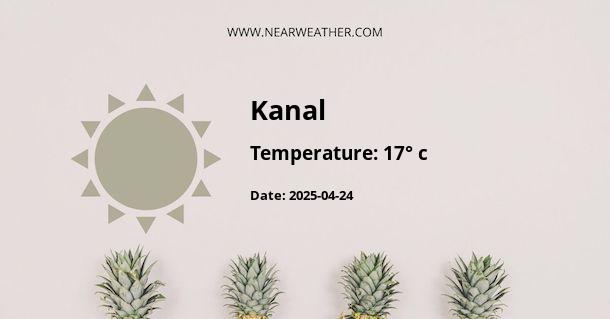Understanding the Climate and Weather Patterns of Kanal, Slovenia
Kanal ob Soči, often simply referred to as Kanal, is a small town and municipality in western Slovenia, in the region of Goriška. Nestled in the picturesque Soča Valley, Kanal boasts a varied climate influenced by the Mediterranean to the south and the Alps to the north. The location's unique geographic positioning introduces complexity to its weather patterns, offering a diverse tapestry of climatic experiences throughout the year.
Geographical Influences on Kanal’s Climate
The Soča Valley, where Kanal is situated, lies at the foothills of the Julian Alps. To the west, the Mediterranean Sea exerts a moderating influence, while the Alpine barrier to the north helps protect the area from cold northern winds. This intricate interplay of mountain and sea gives Kanal its specific sub-Mediterranean climate with some continental influences.
Seasonal Climate Overview
The Kanal region experiences four distinct seasons, each with its own characteristic weather patterns:
- Spring: This season sees the gradual warming from March to June. The melting snows from the higher Alpine regions can cause an increase in river levels, particularly in the Soča, which runs through the town. Precipitation in spring is fairly common, with occasional thunderstorms.
- Summer: Typically warm and sunny, with temperatures often climbing above 25°C (77°F). The proximity to the Mediterranean can bring hot spells, but these are generally tempered by the cool evening breezes from the mountains.
- Autumn: This season wears a cloak of vivid colors as the foliage turns. The climate remains pleasant, with moderate temperatures but the weather gradually cools as winter approaches. Rainfall is frequent in the months of October and November, contributing to the lush greenery of the region.
- Winter: Contrasting to the warm southern winds, the winters can be brisk, with temperatures often dipping below 0°C (32°F). Snowfall is common, particularly at higher altitudes, draping the landscape in white.
Year-Round Weather Patterns and Statistics
The microclimate of Kanal is quite dynamic, leading to an interesting spectrum of weather events throughout the year. Here are some specifics:
- The average annual temperature is roughly between 9°C to 15°C (48°F to 59°F).
- Precipitation levels average at around 1400 mm to 1600 mm annually with a relatively even distribution throughout the year.
- Snow cover in the town itself is sporadic, but the surrounding mountains exhibit a reliable snowpack.
- Sunshine is abundant, particularly from May to September, often exceeding 220 sunny days per year.
Monthly Climate Breakdown
| Month | Avg. Temperature (°C) | Precipitation (mm) | Sunshine Hours |
|---|---|---|---|
| January | 1.5 | 70 | 4 |
| February | 3.5 | 60 | 5 |
| March | 7 | 80 | 4 |
| April | 11.5 | 100 | 6 |
| May | 15.5 | 120 | 7 |
| June | 19 | 140 | 8 |
| July | 21.5 | 100 | 9 |
| August | 21 | 110 | 8 |
| September | 17 | 140 | 7 |
| October | 12 | 180 | 5 |
| November | 7 | 170 | 3 |
| December | 2.5 | 90 | 3 |
Extreme Weather and Climate Events
While Kanal enjoys a relatively temperate climate, extreme weather events can occur, largely due to its topographic diversity:
- Bora Winds: A dry, cold wind known as the Bora can gust down from the mountains, particularly in winter and spring, leading to sudden drops in temperature.
- Thunderstorms: The mixture of warm Mediterranean air with the cooler Alpine climate can result in thunderstorms, occasionally leading to flash flooding.
- Heatwaves: During summer, heatwaves from the Mediterranean can spike temperatures to extreme highs, often triggering health advisories.
Climate Adaptations and Considerations
The residents of Kanal and the surrounding Soča Valley have adapted to their diverse climate in numerous ways:
- Building designs often feature thick walls and small windows, particularly in older structures, to keep interiors cool during summer and warm in winter.
- Agriculture in the region has been tailored to fit the climate, with vineyards, olive groves, and orchards being common, favoring crops that thrive in the sub-Mediterranean conditions.
- Water management systems are in place to handle the high precipitation levels and mitigate flooding risks.
The Role of Climate in Tourism
Kanal's diverse climate attracts tourists year-round, with each season offering its own allure:
- In spring and summer, tourists are drawn to outdoor activities like hiking, kayaking, and cycling thanks to the pleasant weather.
- Autumn's colorful foliage and harvest season create a picturesque backdrop for cultural events and wine tasting.
- Winter attracts those interested in winter sports, with nearby ski resorts benefiting from the reliable snow cover.
Climate Change and Future Outlook
Like many regions around the world, Kanal is facing the impact of climate change with observable effects and consequential concerns:
- Increased frequency of extreme weather events, including heatwaves and intense precipitation.
- Changes in growing seasons, which may affect local agriculture and viticulture.
- Alterations in the patterns of snowfall and snowmelt, impacting water management and winter tourism.
Conclusion
In conclusion, the climate and weather of Kanal, Slovenia, are characterized by their variability and the influence of both Mediterranean and Alpine forces. The patterns observed throughout the year cater to a wide range of activities and have significant implications for the local lifestyle, agriculture, and tourism. With data-driven insights and ongoing adaptations, Kanal continues to be a vibrant community resiliently navigating the complexities of its climatic identity.
A - Kanal's Latitude is 46.088612 & Longitude is 13.639720.
A - Weather in Kanal is 14° today.
A - Climate Conditions in Kanal shows overcast clouds today.
A - Humidity in Kanal is 87% today.
A - Wind speed in Kanal is 3.2 km/h, flowing at 67° wind direction. today.
